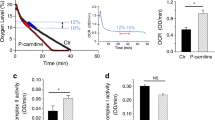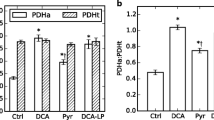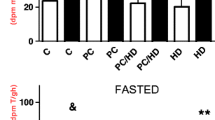Abstract
Objectives
Based on the hypothesis that provision of glucose is good and fatty acids are bad for the ischaemic myocardium, the aims of this study were to determine i) the effects of different substrates on sarcolemmal permeability during normoxia, low-flow hypoxia (HLF) and reperfusion, ii) whether increased membrane permeability is associated with ultrastructural damage and increased influx of Ca2+ into cells and iii) whether changes in membrane permeability correlate with myocardial function and high energy phosphate metabolism.
Methods
The isolated rat heart subjected to HLF was used as model of global ischaemia, and sarcolemmal permeability assessed by release of LDH from and influx of lanthanum and Ca2+ into myocardial tissue. Myocyte structural injury was also evaluated quantitatively, and mechanical activity was monitored throughout the experimental protocol. Results: Regardless of the substrate used, HLF caused a 80–90% and 20–40 % reduction in myocardial oxygen uptake and coronary flow rate, respectively. Palmitate (0.5 mM conjugated to 0.1 mM albumin) or substrate-free perfusion caused ultrastructural damage and loss of normal sarcolemmal integrity during both normoxia and HLF. Although reperfusion reversed injury in some cells, in general, myocytes exhibited myofibrillar contracture, while membrane, integrity recovered to some extent, as indicated by reduced lanthanum influx. Intracellular Ca2+ increased significantly upon reperfusion. Mechanical function as well as tissue high energy phosphates were significantly depressed during both HLF and reperfusion. Glucose, on the other hand, protected against ischaemia-induced structural damage and loss of sarcolemmal integrity. Reperfusion in these experiments resulted in almost complete recovery of normal morphology, ultrastructure and sarcolemmal integrity, while intracellular Ca2+ remained unchanged. Mechanical function and tissue high energy phosphates were significantly higher in glucose-perfused hearts than in palmitate-perfused or substrate-free hearts. Glucose was also able to attenuate the harmful effects of palmitate on myocardial ultrastructure, membrane integrity, mechanical function, energy metabolism and prevented Ca2+ overloading during reperfusion.
Conclusion
The results provide new evidence for the protective role of glucose during myocardial ischaemia and reperfusion. Although the exact mechanism of the beneficial actions of glucose remains to be established, the results suggest that glycolytic flux and thus glycolytically derived ATP protect against ischaemic damage via preservation of membrane integrity.
Similar content being viewed by others
References
Allison SP, Chamberlain MJ, Hinton P (1969) Intravenous glucose tolerance, insulin, glucose and free fatty acid levels after myocardial infarction. Br J Med 4: 776–778
Apstein CS, Gravino FN, Haudenschild CC (1983) Determinants of a protective action of glucose and insulin in the ischaemic myocardium: effects on contractile function, diastolic compliance, metabolism and ultrastructure during ischemia and reperfusion. Circ Res 52: 515–526
Bricknell OL, Opie LH (1978) Effects of substrates on tissue metabolic changes in the isolated rat heart during underperfusion and on release of lactate dehydrogenase and arrhythmias during reperfusion. Circ Res 43: 102–114
Campbell JD, Paul RJ (1992) The nature of fuel provision for the Na+ K+ ATPase in porcine vascular smooth muscle. J Physiol (Lond.) 447: 67–82
Cardoso CM, De Meis L (1993) Modulation by fatty acids of Ca2+ fluxes in sarcoplasmic reticulum vesicles. Biochem J 296: 49–52
Chien KR, Han A, Sen A, Buja LM, Willerson JT (1984) Accumulation of unesterified arachidonic acid in ischemic canine myocardium. Circ Res 54: 313–322
De Kock A, Lochner A, Kotzé JCN, Gevers W (1978) The hypoxic low-flow perfused rat heart: characterization as a model of global ischaemia. Bas Res Cardiol 73: 506–522
De Leiris J, Feuvray D (1977) Ischaemia-induced damage in the working rat heart preparation: the effect of perfusate substrate composition upon subendocardial ultrastructure of the ischaemic left ventricular wall. J Mol Cell Cardiol 9: 365–373
De Leiris J, Lubbe WF, Opie LH (1975) Effects of free fatty acid and glucose on enzyme release in experimental myocardial infarction. Nature 153: 746–747
Eberli FR, Weinberg ED, Grice WN, Horowitz GL, Apstein CS (1991) Protective effects of increased glycolytic substrate against systolic and diastolic dysfunction and increased coronary resistance from prolonged global underperfusion and reperfusion in isolated rabbit hearts perfused with erythrocyte suspension. Circ Res 68: 466–481
Edoute Y, Van der Merwe E, Sanan D, Kotze JCN, Steinmann C, Lochner A (1983) Normothermic ischaemic arrest of the isolated rat heart. Effects of time and reperfusion on myocardial ultrastructure, mitochondrial oxidative function and mechanical recovery. Circ Res 53: 663–678
Entman MC, Kaniike K, Goldstein MA, Nelson TB, Bornet EP, Futch TW, Schwartz A (1976) Association of glycogenolysis with cardiac sarcoplasmic reticulum. J Biol Chem 251: 3140–3146
Ferrari R (1992) Myocardial response to reperfusion after a prolonged period of ischaemia. In: Parrat JR (ed) Myocardial response to acute injury. London, Macmillan, pp. 201–222
Gunn MD, Sen A, Chang A, Willerson JT, Buja LM, Chien KR (1985) Mechanisms of accumulation of arachidonic acid in cultured myocardial cells during ATP depletion. Am J Physiol 249: H1188-H1194
Görge G, Chatelain P, Schaper J, Lerch R (1990) Effect of increasing degrees of ischaemic injury on myocardial oxidative metabolism early after reperfusion in isolated rat hearts. Circ Res 68: 1681–1692
Harper IS, Lochner A (1989) Sarcolemmal integrity during ischaemia and reperfusion of the isolated rat heart. Bas Res Cardiol 84: 208–226
Hasin Y, Barry WH (1984) Myocardial metabolic inhibition and membrane potential, contraction and potassium uptake. Am J Physiol 247: H322-H329
Henry PD, Sobel BE, Braunwald E (1974) Protection of hypoxic guinea pig hearts with glucose and insulin. Am J Physiol 226: 309–313
Higgins TJC, Allsopp D, Bailey PJ, DéSouza EDA (1981) The relationship between glycolysis, fatty acid metabolism and membrane integrity in neonatal myocytes. J Mol Cell Cardiol 13: 599–615
Huang JM, Xian H, Bacaner M (1992) Long chain fatty acids activate calcium channels in ventricular myocytes. Proc Natl Acad Sci 89: 6452–6456
Jeremy RW, Koretsune Y, Marban E, Becker LC (1992) Relation between glycolysis and calcium homeostasis in postischaemic myocardium. Circ Res 70: 1180–1190
Katz AM, Messineo FC (1981) Lipidmembrane interactions and the pathogenesis of ischaemic damage in the myocardium. Circ Res 48: 1–16
Kusuoka H, Marban E (1994) Mechanism of the diastolic dysfunction induced by glycolytic inhibition. J Clin Invest 93: 1216–1223
Lampbrecht W, Trautschold I (1974) ATP: determination with hexokinase and glucose-6-phosphate dehydrogenase. In: Bergmeyer HU (ed) Methods of enzymatic analysis; Academic Press, New York p. 2105
Liedtke AJ (1981) Alterations of carbohydrate and lipid metabolism in the acutely ischaemic heart. Progress Cardiovasc Res 23: 321–336
Liedtke AJ, Demaison L, Eggleston AM Cohen LM, Ellis SH (1988) Changes in substrate metabolism and effects of excess fatty acids in reperfused myocardium. Circ Res 62: 535–542
Lochner A, De Villiers M (1989) Phosphatidylcholine biosynthesis in myocardial ischaemia. J Mol Cell Cardiol 21: 151–163
Lopaschuk GD, Spafford MA, Davies NJ, Wall SR (1990) Glucose and plamitate oxidation in isolated working rat hearts reperfused after a period of transient global ischaemia. Circ Res 66: 546–553
Moolman JA, Genade S, Malan JF, Williams K, Salie R, Jordaan A, Lochner A (1994) Preconditioning with global ischaemia in the isolated working rat heart model. Cardiovasc Drugs & Therapy 9: 103–115
Mueller HS, Ayres ST (1978) Metabolic responses of the heart in acute myocardial infarction in man. Am J Cardiol 42: 363–371
Myears DW, Sobel BE, Bergmann SR (1987) Substrate use in ischaemic and reperfused canine myocardium: quantitative considerations. Am J Physiol 253: H107-H114
Nathan RD, Kanai K, Clark RB, Giles W (1989) Selective block of calcium current by lanthanum in single bullforg atrial cells. J Gen Physiol 91: 549–572
Nayler WG, Perry SE, Elz JS, Daly MJ (1984) Calcium, sodium and the calcium paradox. Circ Res 55: 227–237
Neely JR, Grotyohann LW (1984) Role of glycolytic products in damage to ischemic myocardium: dissociation of adenosine triphosphate levels and recovery of function of reperfused ischaemic hearts. Circ Res 55: 816–824
Neely JR, Worgan HE (1984) Relationship between carbohydrate and lipid metabolism and the energy balance of heart muscle. Ann Rev Physiol 36: 413–459
Neely JR, Whitmer JT, Rovetto MJ (1975) Effect of coronary blood flow on glycolytic flux and intracellular pH in isolated rat hearts. Circ Res 37: 733–741
Nishimura M, Takami H, Kaneko M, Nakano S, Matsuda H, Kurosawa K, Inoue T, Tagawa K (1993) Mechanism of mitochondrial enzyme leakage during reoxygenation of the rat heart. Cardiovasc Res 27: 1116–1122
Oliver MF, Kurien VA, Greenwood TW (1968) Relation between serum-free-fatty-acids and arrhythmias and death after acute myocardial infarction. Lancet 1: 710–714
Oliver MF, Opie LH (1994) Effects of glucose and fatty acids on myocardial ischaemia and arrhythmias. The Lancet 343: 155–158
Opie LH (1970) The glucose hypothesis: relation to acute myocardial ischaemia. J Mol Cell Cardiol 1: 107–115
Opie LH (1976) Effects of regional ischaemia on metabolism of glucose and fatty acids. Circ Res 38 Suppl I: 1–52
Opie LH (1984) The Heart. Grune and Stratton, London, p. 31
Opie LH (1991) The Heart. Physiology and Metabolism, Chapter 10. Raven Press, New York, Second Edition
Opie LH, Bruyneel IL, Owen P (1975) Effects of glucose, potassium and insulin infusion on tissue metabolic changes within first two hours of myocardial infarction in the baboon. Circulation 52: 49–57
Owen P, Dennis S, Opie LH (1990) Glucose flux regulates onset of ischaemic contracture in globally underperfused rat hearts. Circ Res 66: 344–354
Paul RJ, Hardin CH, Raeymackers L, Wuytack F, Casteels R (1989) Preferential support of Ca2+ uptake in smooth muscle plasma membrane vesicles by an endogenous glycolytic cascade. FASEB J 3: 2298–2301
Peeters GA, Kohmoto O, Barry WH (1989) Detection of La3+ influx in ventricular cells by indo-1 fluorescence. Am J Physiol 256: C351-C357
Pierce GN, Philipson KD (1985) Binding of glycolytic enzymes to cardiac sarcolemmal and sarcoplasmic reticular membranes. J Biol Chem 260: 6862–6870
Renstrom B, Nellis SH, Liedtke AJ (1989) Metabolic oxidation of glucose during early myocardial reperfusion. Circ Res 65: 1094–1101
Rovetto MJ, Whitmer JT, Neely JR (1973) Comparison of the effects of anoxia and whole heart ischaemia on carbohydrate utilization in isolated working rat hearts. Circ Res 32: 699–711
Schwarz P, Piper HM, Spahr R, Spieckerman PG (1984) Ultrastructure of cultured adult myocardial cells during anoxia and reoxygenation. Am J Pathol 115: 349–361
Tamm C, Benzi R, Papageorgiou I, Tardy I, Lerch R (1994) Substrate competition in postischemic myocardium: effect of substrate availability during reperfusion on metabolic and contractile recovery in isolated rat hearts. Circ Res 75: 1103–1112
Van der Vusse GJ, Stam H (1987) Lipid and carbohydrate metabolism in the ischaemic heart. Bas Res Cardiol 82 (Suppl 1): 149–154
Victor T, Bester AJ, Lochner A (1987) A sensitive and rapid method for separating adenine nucleotides and creatine phosphate by ion-pair-reversed-phase high-performance liquid chromatography. J Chromatogr 389: 339–344
Wiegmund B, Koop A, Klietz T, Schwartz P, Piper HM (1990) Sarcolemmal integrity and metabolic competence of cardiomyocytes under anoxia-reoxygenation. Am J Physiol 258: H285–291
Wroblewski F, La Due JS (1955) Lactate dehydrogenase activity in blood. Proc Soc Exp Biol Med 90: 210–213
Author information
Authors and Affiliations
Rights and permissions
About this article
Cite this article
Lochner, A., Pentz, A., Williams, K. et al. Substrate effects on sarcolemmal permeability in the normoxic and hypoxic perfused rat heart. Basic Res Cardiol 91, 64–78 (1996). https://doi.org/10.1007/BF00788867
Received:
Revised:
Accepted:
Issue Date:
DOI: https://doi.org/10.1007/BF00788867




